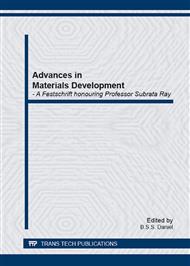[1]
J. A. Eastman, S. U. S. Choi, S. Li, W. Yu and L. J. Thompson, Anomalously increased effective thermal conductivities of ethylene glycol-based nanofluids containing copper nanoparticles, Appl. Phys. Lett. 78 (2001) 718-720.
DOI: 10.1063/1.1341218
Google Scholar
[2]
S. U. S. Choi, Z. G. Zhang, W. Yu, F. E. Lockwood and E. A. Grulke, Anomalous thermal conductivity enhancement in nanotube suspensions, Appl. Phys. Lett. 79 (2001) 2252-2254.
DOI: 10.1063/1.1408272
Google Scholar
[3]
S. K. Das, N. Putra, P. Thiesen and W. Roetzel, Temperature dependence of thermal conductivity enhancement for nanofluids, J. Heat Transf. 125 (2003) 567-574.
DOI: 10.1115/1.1571080
Google Scholar
[4]
H. E. Patel, S. K. Das, T. Sundararajan, A. S. Nair, B. George and T. Pradeep, Thermal conductivities of naked and monolayer protected metal nanoparticle based nanofluids: Manifestation of anomalous enhancement and chemical effects, Appl. Phys. Lett. 83 (2003).
DOI: 10.1063/1.1602578
Google Scholar
[5]
S. Lee, S. U. S. Choi, S. Li and J. A. Eastman, Measuring thermal conductivity of fluids containing oxide nanoparticles, J. Heat Transf. 121 (1999) 280-289.
DOI: 10.1115/1.2825978
Google Scholar
[6]
R. K. Shukla and V. K. Dhir, Study of the effective thermal conductivity of nanofluids, in: Proceedings of the ASME International Mechanical Engineering Congress and Exposition (Orlando, Florida, USA), November 5-11, 2005, pp.1-5.
Google Scholar
[7]
P. Bhattacharya, S. K. Saha, A. Yadav, P. E. Phelan and R. S. Prasher, Brownian dynamics simulation to determine the effective thermal conductivity of nanofluids, J. Appl. Phys. 95 (2004) 6492-6494.
DOI: 10.1063/1.1736319
Google Scholar
[8]
S. P. Jang and S. U. S. Choi, Role of Brownian motion in the enhanced thermal conductivity of nanofluids, Appl. Phys. Lett. 84 (2004) 4316-4318.
DOI: 10.1063/1.1756684
Google Scholar
[9]
R. Prasher, P. Bhattacharya and P. E. Phelan, Brownian-motion-based convective-conductive model for the effective thermal conductivity of nanofluids, J. Heat Transf. 128 (2006) 588-595.
DOI: 10.1115/1.2188509
Google Scholar
[10]
K. C. Leong, C. Yang and S. M. S. Murshed, A model for the thermal conductivity of nanofluids-the effect of interfacial layer, J. Nanopart. Res. 8 (2006) 245-254.
DOI: 10.1007/s11051-005-9018-9
Google Scholar
[11]
R. Prasher, W. Evans, P. Meakin, J. Fish, P. Phelan and P. Keblinski, Effect of aggregation on thermal conduction in colloidal nanofluids, Appl. Phys. Lett. 89 (2006) 143119-1-3.
DOI: 10.1063/1.2360229
Google Scholar
[12]
J. C. Maxwell, A Treatise on Electricity and Magnetism, 2nd ed., Oxford University Press, Cambridge, 1904, pp.435-441.
Google Scholar
[13]
R. L. Hamilton and O. K. Crosser, Thermal conductivity of heterogeneous two-component systems, I& EC Fundamentals 1 (1962) 187-191.
DOI: 10.1021/i160003a005
Google Scholar
[14]
M. M. Ghosh, S. Roy, S. K. Pabi and S. Ghosh, A molecular dynamics-stochastic model for thermal conductivity of nanofluids and its experimental validation, J. Nanosci. Nanotechnol. 11 (2011) 2196-2207.
DOI: 10.1166/jnn.2011.3557
Google Scholar
[15]
W. John, G. Reischl and W. Devor, Charge transfer to metal surfaces from bouncing aerosol particles, J. Aerosol Sci. 11 (1980) 115-138.
DOI: 10.1016/0021-8502(80)90029-4
Google Scholar
[16]
J. Eapen, W. C. Williams, J. Buongiorno, L. W. Hu, S. Yip, R. Rusconi and R. Piazza, Mean-field versus microconvection effects in nanofluid thermal conduction, Phys. Rev. Lett. 99 (2007) 095901-1-4.
DOI: 10.1103/physrevlett.99.095901
Google Scholar


